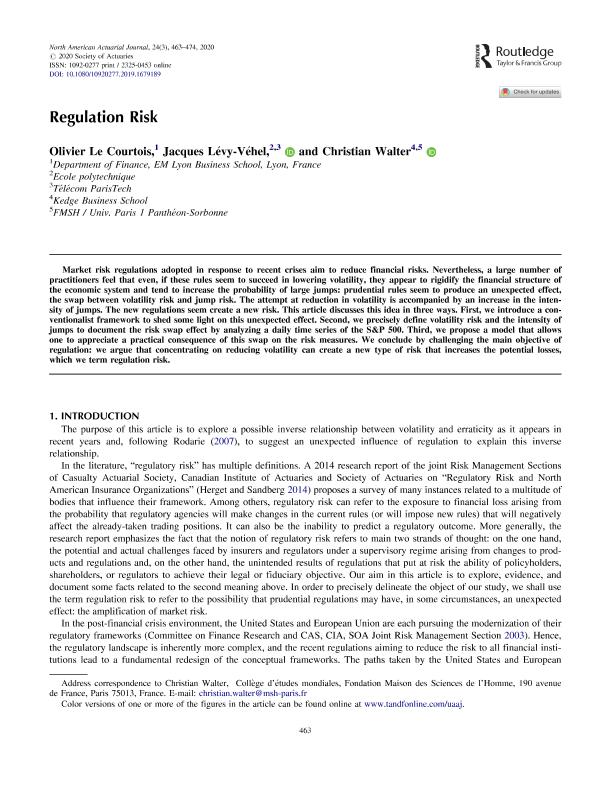Regulation risk

Contenido multimedia no disponible por derechos de autor o por acceso restringido. Contacte con la institución para más información.
| Tag | 1 | 2 | Valor |
|---|---|---|---|
| LDR | 00000cab a2200000 4500 | ||
| 001 | MAP20200031567 | ||
| 003 | MAP | ||
| 005 | 20201006140937.0 | ||
| 008 | 201006e20200901usa|||p |0|||b|eng d | ||
| 040 | $aMAP$bspa$dMAP | ||
| 084 | $a7 | ||
| 100 | $0MAPA20090003767$aCourtois, Olivier Le | ||
| 245 | 1 | 0 | $aRegulation risk$cOlivier Le Courtois, Jacques Lévy-Véhel, Christian Walter |
| 520 | $aMarket risk regulations adopted in response to recent crises aim to reduce financial risks. Nevertheless, a large number of practitioners feel that even, if these rules seem to succeed in lowering volatility, they appear to rigidify the financial structure of the economic system and tend to increase the probability of large jumps: prudential rules seem to produce an unexpected effect, the swap between volatility risk and jump risk. The attempt at reduction in volatility is accompanied by an increase in the intensity of jumps. The new regulations seem create a new risk. This article discusses this idea in three ways. First, we introduce a conventionalist framework to shed some light on this unexpected effect. Second, we precisely define volatility risk and the intensity of jumps to document the risk swap effect by analyzing a daily time series of the S&P 500. Third, we propose a model that allows one to appreciate a practical consequence of this swap on the risk measures. We conclude by challenging the main objective of regulation: we argue that concentrating on reducing volatility can create a new type of risk that increases the potential losses, which we term regulation risk. | ||
| 650 | 4 | $0MAPA20080591182$aGerencia de riesgos | |
| 650 | 4 | $0MAPA20080582418$aRiesgo financiero | |
| 650 | 4 | $0MAPA20080592011$aModelos actuariales | |
| 650 | 4 | $0MAPA20080579258$aCálculo actuarial | |
| 650 | 4 | $0MAPA20180004223$aRegulación | |
| 700 | 1 | $0MAPA20200020165$aLévy-Véhel, Jacques | |
| 700 | 1 | $0MAPA20200020172$aWalter, Christian | |
| 773 | 0 | $wMAP20077000239$tNorth American actuarial journal$dSchaumburg : Society of Actuaries, 1997-$x1092-0277$g01/09/2020 Tomo 24 Número 3 - 2020 , p. 463-474 |

